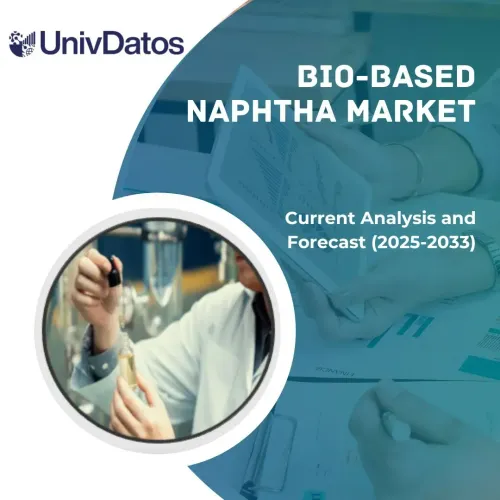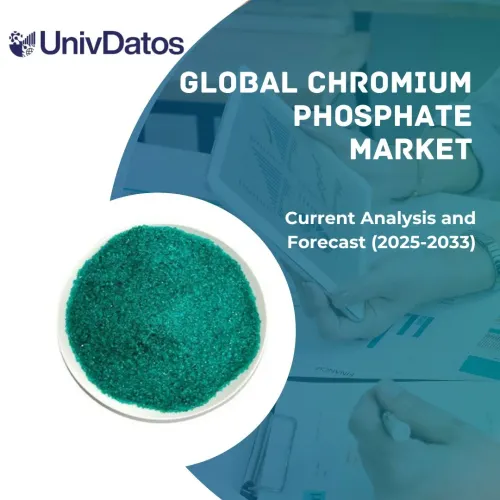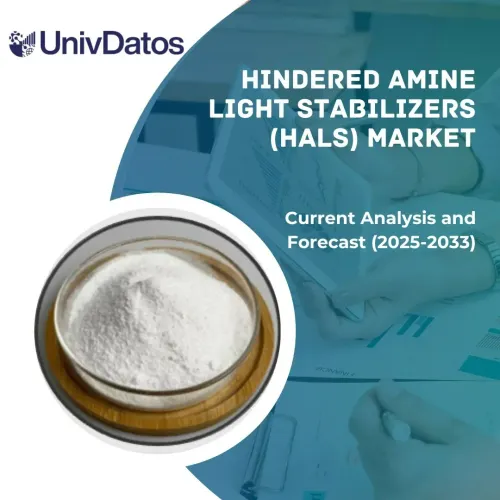- Inicio
- Acerca de nosotros
- Industria
- Servicios
- Leyendo
- Contáctenos
Mercado de alcohol éster de Texanol: Análisis y pronóstico actuales (2023-2030)
Énfasis en el tipo de producto (alcohol éster primario y alcohol éster secundario), aplicación (pinturas y recubrimientos, adhesivos y selladores, tintas de impresión, plásticos y otros) y región/país
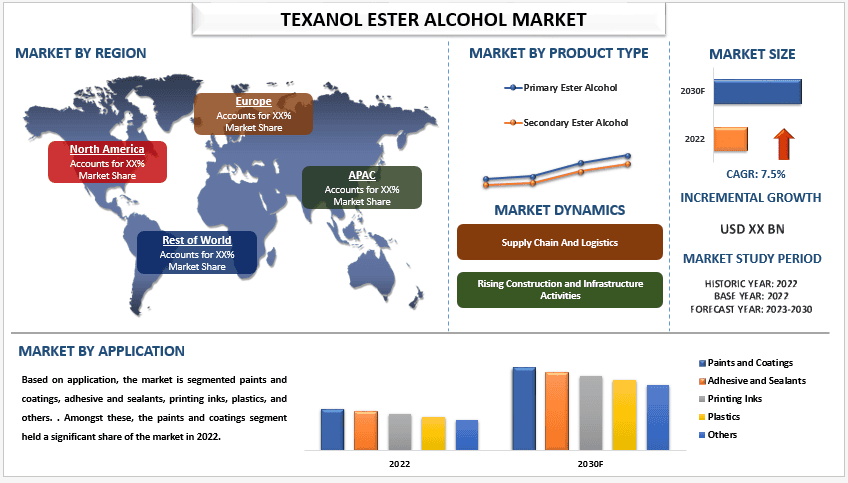
Se espera que el mercado de alcohol éster de Texanol crezca a una sólida CAGR de alrededor del 7,50% durante el período de pronóstico 2023-2030.La creciente demanda de productos químicos especiales en diversas industrias, como la farmacéutica, la cosmética y la agroquímica, es un factor importante. Los continuos avances tecnológicos contribuyen al desarrollo de ésteres y alcoholes nuevos y mejorados con propiedades mejoradas. Esto estimula la innovación en el mercado y atrae a las industrias que buscan soluciones avanzadas. Además, el crecimiento de las industrias automotriz y de la construcción juega un papel fundamental. Los lubricantes a base de ésteres, los plastificantes y los productos químicos para la construcción derivados de alcoholes son componentes integrales, que contribuyen a la expansión de la cuota de mercado.
Algunos de los principales actores que operan en el mercado son Exxon Mobil Corporation, Dow, Arkema, BASF SE, Celanese Corporation, Eastman Chemical Company, Huntsman International LLC, Momentive, The Lubrizol Corporation y Westlake Corporation. Estos actores han llevado a cabo varias fusiones y adquisiciones, así como asociaciones, para facilitar a los clientes productos/tecnologías innovadoras y de alta tecnología.
Perspectivas presentadas en el informe
“Entre las aplicaciones, el segmento de tintas de impresión mantuvo un crecimiento significativo en el mercado en 2022.”
Según la aplicación, el mercado se segmenta en pinturas y recubrimientos, adhesivos y selladores, tintas de impresión, plásticos y otros. Entre estos, el segmento de tintas de impresión mantuvo un crecimiento significativo en el mercado en 2022 debido a la mejor adhesión de la tinta a diversos sustratos como papel, plástico y metal, lo que lleva a impresiones más nítidas y a la reducción de manchas. Además, la viscosidad y las propiedades de secado de TEAL lo hacen ideal para la impresión de inyección de tinta, lo que garantiza un flujo de tinta suave y una colocación precisa de las gotas.
“Entre el tipo de producto, el alcohol éster primario mantuvo un crecimiento significativo en el mercado. ’’
Según el tipo de producto, el mercado se segmenta en alcohol éster primario y alcohol éster secundario. Entre estos, el segmento de fluidos de transmisión mantuvo un crecimiento significativo del mercado de alcohol éster de Texanol en 2022 porque los alcoholes secundarios pueden usarse como co-reactantes en la síntesis de TEAL. La mezcla de alcoholes primarios y secundarios con catalizadores específicos puede dar como resultado ésteres de TEAL ramificados con diferentes propiedades. Estos TEAL ramificados pueden ofrecer ventajas como una flexibilidad mejorada, la formación de película y la adhesión, lo que los hace adecuados para aplicaciones específicas.
“Europa mantuvo una cuota significativa en el mercado de alcohol éster de Texanol en 2022.”
La cuota de Europa en el mercado global de alcohol éster de Texanol (TEAL) es, de hecho, significativa, y se prevé que su crecimiento sea constante, aunque no tan explosivo como el de Asia Pacífico. Los consumidores europeos son cada vez más conscientes del impacto ambiental de los productos que utilizan. La biodegradabilidad y la renovabilidad de TEAL se alinean con esta creciente preferencia por los productos sostenibles, lo que impulsa su atractivo en todas las industrias. Además, Europa cuenta con una industria química bien establecida y tecnológicamente avanzada con fuertes capacidades de investigación y desarrollo. Esto fomenta la innovación en la producción y aplicación de TEAL, impulsando aún más el crecimiento del mercado
Cobertura del informe del mercado de alcohol éster de Texanol
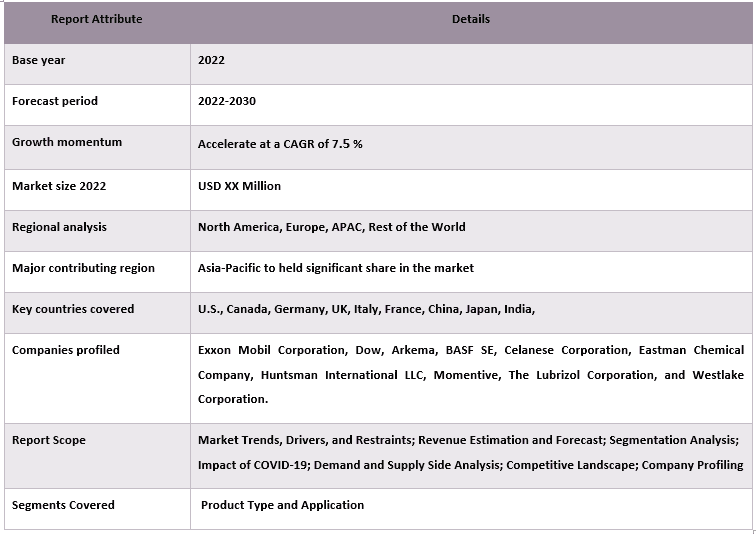
Razones para comprar este informe:
- El estudio incluye el dimensionamiento del mercado y el análisis de pronóstico validados por expertos clave de la industria autenticados.
- El informe presenta una revisión rápida del rendimiento general de la industria de un vistazo.
- El informe cubre un análisis en profundidad de los principales competidores de la industria, con un enfoque principal en las finanzas comerciales clave, las carteras de productos, las estrategias de expansión y los desarrollos recientes.
- Examen detallado de los impulsores, las restricciones, las tendencias clave y las oportunidades que prevalecen en la industria.
- El estudio cubre ampliamente el mercado en diferentes segmentos.
- Análisis en profundidad a nivel regional de la industria.
Opciones de personalización:
El mercado global de alcohol éster de Texanol se puede personalizar aún más según el requisito o cualquier otro segmento de mercado. Además de esto, UMI entiende que puede tener sus propias necesidades comerciales, por lo tanto, no dude en contactarnos para obtener un informe que se adapte completamente a sus requisitos.
Tabla de contenido
Metodología de investigación para el análisis del mercado de alcohol éster de Texanol (2022-2030)
El análisis del mercado histórico, la estimación del mercado actual y la previsión del mercado futuro del mercado global de alcohol éster de Texanol fueron los tres pasos principales realizados para crear y analizar la adopción de tejidos de PTFE en las principales regiones a nivel mundial. Se llevó a cabo una extensa investigación secundaria para recopilar los números históricos del mercado y estimar el tamaño actual del mercado. En segundo lugar, para validar estos conocimientos, se tuvieron en cuenta numerosos hallazgos y supuestos. Además, también se realizaron exhaustivas entrevistas primarias con expertos de la industria a través de la cadena de valor del mercado global de alcohol éster de Texanol. Después de la asunción y validación de los números de mercado a través de entrevistas primarias, empleamos un enfoque de arriba hacia abajo/de abajo hacia arriba para pronosticar el tamaño completo del mercado. Posteriormente, se adoptaron métodos de desglose del mercado y triangulación de datos para estimar y analizar el tamaño del mercado de los segmentos y subsegmentos de la industria que corresponda. La metodología detallada se explica a continuación:
Análisis del tamaño histórico del mercado
Paso 1: Estudio en profundidad de fuentes secundarias:
Se realizó un estudio secundario detallado para obtener el tamaño histórico del mercado del mercado de alcohol éster de Texanol a través de fuentes internas de la empresa, tales comoinformes anuales y estados financieros, presentaciones de rendimiento, comunicados de prensa, etc.y fuentes externas, incluyendorevistas, noticias y artículos, publicaciones gubernamentales, publicaciones de la competencia, informes sectoriales, bases de datos de terceros y otras publicaciones creíbles.
Paso 2: Segmentación del mercado:
Después de obtener el tamaño histórico del mercado del mercado de alcohol éster de Texanol, realizamos un análisis secundario detallado para recopilar información histórica del mercado y la cuota de los diferentes segmentos y subsegmentos para las principales regiones. Los principales segmentos están incluidos en el informe como tipo de producto y aplicación. Además, se realizaron análisis a nivel de país para evaluar la adopción general de modelos de prueba en esa región.
Paso 3: Análisis de factores:
Después de adquirir el tamaño histórico del mercado de diferentes segmentos y subsegmentos, realizamos unanálisis de factorespara estimar el tamaño actual del mercado del mercado de alcohol éster de Texanol. Además, realizamos un análisis de factores utilizando variables dependientes e independientes, como el tipo de vehículo, el tipo de producto y el aceite base del mercado de alcohol éster de Texanol. Se llevó a cabo un análisis exhaustivo de los escenarios de la oferta y la demanda, considerando las principales asociaciones, fusiones y adquisiciones, la expansión empresarial y los lanzamientos de productos en el sector del mercado de alcohol éster de Texanol en todo el mundo.
Estimación y previsión del tamaño actual del mercado
Dimensionamiento actual del mercado:Basándonos en información útil de los 3 pasos anteriores, llegamos al tamaño actual del mercado, los actores clave en el mercado global de alcohol éster de Texanol y las cuotas de mercado de los segmentos. Todas las divisiones de cuotas porcentuales requeridas y los desgloses del mercado se determinaron utilizando el enfoque secundario antes mencionado y se verificaron a través de entrevistas primarias.
Estimación y previsión:Para la estimación y previsión del mercado, se asignaron ponderaciones a diferentes factores, incluidos los impulsores y tendencias, las restricciones y las oportunidades disponibles para las partes interesadas. Después de analizar estos factores, se aplicaron técnicas de previsión relevantes, es decir, el enfoque de arriba hacia abajo/de abajo hacia arriba, para llegar a la previsión del mercado para 2028 para diferentes segmentos y subsegmentos en los principales mercados a nivel mundial. La metodología de investigación adoptada para estimar el tamaño del mercado abarca:
- El tamaño del mercado de la industria, en términos de ingresos (USD) y la tasa de adopción del mercado de alcohol éster de Texanol en los principales mercados a nivel nacional
- Todas las cuotas porcentuales, divisiones y desgloses de los segmentos y subsegmentos del mercado
- Actores clave en el mercado global de alcohol éster de Texanol en términos de productos ofrecidos. Además, las estrategias de crecimiento adoptadas por estos actores para competir en el mercado de rápido crecimiento.
Validación del tamaño y la cuota de mercado
Investigación primaria:Se realizaron entrevistas en profundidad con los Líderes de Opinión Clave (KOL), incluidos los ejecutivos de alto nivel (CXO/VP, Jefe de Ventas, Jefe de Marketing, Jefe de Operaciones, Jefe Regional, Jefe de País, etc.) en las principales regiones. Los hallazgos de la investigación primaria se resumieron y se realizó un análisis estadístico para probar la hipótesis establecida. Las entradas de la investigación primaria se consolidaron con los hallazgos secundarios, convirtiendo así la información en conocimientos procesables.
Distribución de los Participantes Primarios en Diferentes Regiones
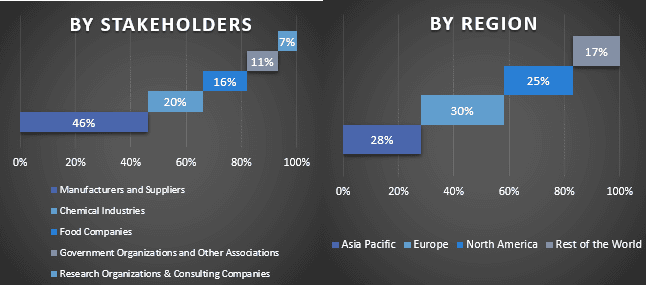
Ingeniería de Mercado
Se empleó la técnica de triangulación de datos para completar la estimación general del mercado y para llegar a números estadísticos precisos para cada segmento y subsegmento del mercado global de alcohol éster texanol. Los datos se dividieron en varios segmentos y subsegmentos después de estudiar varios parámetros y tendencias en las áreas de tipo de vehículo y tecnología en el mercado global de alcohol éster texanol.
El objetivo principal del Estudio del Mercado Global de Alcohol Éster Texanol
Las tendencias actuales y futuras del mercado global de alcohol éster texanol se identificaron en el estudio. Los inversores pueden obtener información estratégica para basar su criterio de inversión en el análisis cualitativo y cuantitativo realizado en el estudio. Las tendencias actuales y futuras del mercado determinaron el atractivo general del mercado a nivel regional, proporcionando una plataforma para que el participante industrial explote el mercado sin explotar para beneficiarse de la ventaja del primero en actuar. Otros objetivos cuantitativos de los estudios incluyen:
- Analizar el tamaño actual y previsto del mercado de alcohol éster texanol en términos de valor (USD). Además, analizar el tamaño actual y previsto del mercado de diferentes segmentos y subsegmentos.
- Los segmentos en el estudio incluyen áreas como el tipo de producto y la aplicación.
- Definir y analizar el marco regulatorio para el alcohol éster texanol
- Analizar la cadena de valor involucrada con la presencia de varios intermediarios, junto con el análisis de los comportamientos de los clientes y competidores de la industria.
- Analizar el tamaño actual y previsto del mercado de alcohol éster texanol para la región principal.
- Los principales países de las regiones estudiadas en el informe incluyen Asia Pacífico, Europa, América del Norte y el resto del mundo
- Perfiles de empresas del mercado de alcohol éster texanol y las estrategias de crecimiento adoptadas por los actores del mercado para mantenerse en el mercado de rápido crecimiento.
- Análisis en profundidad a nivel regional de la industria
Preguntas frecuentes Preguntas frecuentes
P1: ¿Cuál es el tamaño actual del mercado y el potencial de crecimiento del Mercado global de alcohol éster de texanol?
P2: ¿Cuáles son los factores impulsores del crecimiento del mercado global de alcohol éster de texanol?
P3: ¿Qué segmento tiene la mayor cuota del mercado global de alcohol éster de texanol por aplicación?
P4: ¿Qué región dominará el Mercado global de alcohol éster de texanol?
P5: ¿Quiénes son los actores clave que operan en el mercado global de alcohol éster de texanol?
Relacionados Informes
Los clientes que compraron este artículo también compraron



